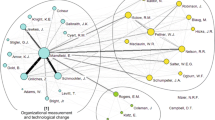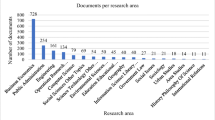Abstract
The state is still the significant unit for innovative studies during the age of R&D globalization and innovation regionalization. Using the bibliometric method, this paper attempts to provide a comprehensive picture of national innovation studies based on data derived from the Web of Knowledge. In particular, we identify the most significant countries and institutions, major journals, seminal contributions and contributors, and clusters in the network of citations in the field of national innovation studies. The results are useful for understanding and promoting the field of national innovation.


Similar content being viewed by others
Notes
In this paper, the term of national innovation system is equal to the term national system of innovation.
The code corresponds to the literature in Appendix Table 8.
A suggestion from Naubahar Sharif, Associate Professor, Division of Social Science, Hong Kong University of Science and Technology.
References
Archibugi, D., & Michie, J. (1995). The globalization of technology—A new taxonomy. Cambridge Journal of Economics, 19(1), 121–140.
Bollen, J., Van de Sompel, H., Smith, A. J., & Luce, R. (2005). Toward alternative metrics of journal impact: A comparison of download and citation data. Information Processing and Management, 41(6), 1419–1440.
Bush, V. (1945). Science, the endless frontier: A report to the president. Washington, DC: U.S. Government Printing Office.
Carlsson, B. (2006). Internationalization of innovation systems: A survey of the literature. Research Policy, 35(1), 56–67.
Carlsson, B. (2007). Innovation systems: A survey of the literature from a Schumpeterian perspective. In H. Hanusch & A. Pyka (Eds.), Elgar companion to Neo-Schumpeterian economics. Cheltenham: Edward Elgar Publishing.
Carlsson, B., Jacobsson, S., Holmén, M., & Rickne, A. (2002). Innovation systems: Analytical and methodological issues. Research Policy, 31(3), 233–245.
Christensen, C. M. (1997). The innovator’s dilemma: When new technologies cause great firms to fail. Cambridge: Harvard Business School Press.
Christensen, C. M., & Raynor, M. E. (2003). The innovator’s solution: Creating and sustaining successful growth. Cambridge: Harvard Business School Press.
Cooke, P. (1992). Regional innovation systems: Competitive regulation in the new Europe. Geoforum, 23(3), 365–382.
Cooke, P. (2001). Regional innovation systems, clusters, and the knowledge economy. Industrial and Corporate Change, 10(4), 945–974.
Cooke, P., & Morgan, K. (1994). The regional innovation system in Baden–Württemberg. International Journal of Technology Management, 9(3–4), 394–429.
Cooke, P., Uranga, M. G., & Etxebarria, G. (1997). Regional innovation systems: Institutional and organisational dimensions. Research Policy, 26(4–5), 475–491.
Cooke, P., Uranga, M. G., & Etxebarria, G. (1998). Regional systems of innovation: An evolutionary perspective. Environment and Planning A, 30(9), 1563–1584.
Dicken, P. (2007). Global shift: Mapping the changing contours of the world economy. New York: Guilford Press.
Dorta-González, P., & Dorta-González, M. I. (2013). Comparing journals from different fields of science and social science through a JCR subject categories normalized impact factor. Scientometrics, 95(2), 645–672.
Edquist, C. (2004). Systems of innovation: Perspectives and challenges. In J. Fagerberg, D. C. Mowery, & R. R. Nelson (Eds.), The Oxford handbook of innovation. Oxford: Oxford University Press.
Etzkowitz, H., & Leydesdorff, L. (2000). The dynamics of innovation: From National Systems and “Mode 2” to a Triple Helix of university–industry–government relations. Research Policy, 29(2), 109–123.
Fagerberg, J. (2004). Innovation: A guide to the literature. In J. Fagerberg, D. C. Mowery, & R. R. Nelson (Eds.), Oxford handbook of innovation. Oxford: Oxford University Press.
Fagerberg, J., & Sapprasert, K. (2011). National innovation systems: The emergence of a new approach. Science and Public Policy, 38(9), 669–679.
Freeman, C. (1987). Technology policy and economic performance: Lessons from Japan. London: Pinter.
Freeman, C. (1995). The ‘National System of Innovation’ in historical perspective. Cambridge Journal of Economics, 19(1), 5–24.
Furman, J. L., & Hayes, R. (2004). Catching up or standing still? National innovative capacity among ‘follower’ countries, 1978–1999. Research Policy, 33(9), 1329–1354.
Furman, J. L., Porter, M. E., & Stern, S. (2002). The determinants of national innovative capacity. Research Policy, 31(6), 899–933.
Garfield, E. (2009). From the science of science to Scientometrics visualizing the history of science with HistCite software. Journal of Informetrics, 3(3), 173–179.
Garfield, E., Pudovkin A. I., & Istomin, V. S. (2002). Algorithmic citation-linked historiography—Mapping the literature of science. Presented the ASIS&T 2002: Information, Connections and Community. 65th Annual Meeting of ASIST in Philadelphia, PA. November 18–21, 2002.
Garfield, E., Paris, S., & Stock, W. G. (2006). HistCite: A software tool for informetric analysis of citation linkage. Information Wissenschaft und Praxis, 57(8), 391–400.
Godin, B. (2009). National innovation system: The system approach in historical perspective. Science Technology Human Values, 34(4), 476–501.
Goto, A., & Wakasugi, R. (1987). Technology policy in Japan: A short review. Technovation, 5(4), 269–279.
Hu, M. C., & Mathews, J. A. (2005). National innovation capacity in East Asia. Research Policy, 34(9), 1322–1349.
Hu, M. C., & Mathews, J. A. (2008). China’s national innovative capacity. Research Policy, 37(9), 1465–1479.
Leydesdorff, L., & Meyer, M. (2006). Triple Helix indicators of knowledge-based innovation systems: Introduction to the special issue. Research Policy, 35(9), 1441–1449.
Leydesdorff, L., & Van den Besselaar, P. (Eds.). (1994). Evolutionary economics and chaos theory: New directions in technology studies. London: Pinter.
Linton, J. D. (2006). Ranking of technology and innovation management journals. Technovation, 26(1), 285–287.
Lucio-Arias, D., & Leydesdorff, L. (2008). Main-path analysis and path-dependent transitions in HistCite™-based historiograms. Journal of the American Society for Information Science and Technology, 59(12), 1948–1962.
Lundvall, B. A. (1985). Product innovation and user-producer interaction. Industrial Development Research Series No. 31. Aalborg University Press. http://www.globelicsacademy.org/2011_pdf/Lundvall%20user-producer.pdf.
Lundvall, B. A. (Ed.). (1992). National systems of innovation: Towards a theory of innovation and interactive learning. London: Pinter.
Lundvall, B. A. (2007). National innovation systems: From List to Freeman. In H. Hanusch & A. Pyka (Eds.), Elgar companion to Neo-Schumpeterian economics. Cheltenham: Edward Elgar Publishing.
Lundvall, B. A., Johnson, B., Andersen, E. S., & Dalum, B. (2002). National systems of production, innovation and competence building. Research Policy, 31(2), 213–231.
Malerba, F. (2002). Sectoral systems of innovation and production. Research Policy, 31(2), 247–264.
Moed, F. H., & Van Leeuwen, N. T. (1995). Improving the accuracy of Institute for Scientific Information’s journal impact factors. Journal of The American Society for Information Science, 46(6), 461–467.
Nelson, R. R. (1993). National innovation systems: A comparative study. New York, Oxford: Oxford University Press.
Niosi, J. (2002). National systems of innovations are “x-efficient” (and x-effective): Why some are slow learners. Research Policy, 31(3), 291–302.
Niosi, J., & Bellon, B. (1994). The global interdependence of national innovation systems: Evidence, limits and implications. Technology in Society, 16(2), 173–197.
Porter, M. E. (1990). The competitive advantage of nations. New York: Free Press.
Romer, P. M. (1990). Endogenous technological change. Journal of Political Economy, 98(5), 71–102.
Schumpeter, J. A. (1934). The theory of economic development. Cambridge: Harvard University Press.
Schumpeter, J. A. (1942). Capitalism, socialism and democracy. New York: Harper.
Shane, S. (1992). Why do some societies invent more than others? Journal of Business Venturing, 7(7), 29–46.
Shane, S. (1993). Cultural influences on national differences in rates of innovation. Journal of Business Venturing, 8(1), 59–74.
Shane, S. (1995). Uncertainty avoidance and the preference for innovation championing roles. Journal of International Business Studies, 26(1), 27–68.
Sharif, N. (2006). Emergence and development of the national innovation systems concept. Research Policy, 35(5), 745–766.
Sombatsompop, N., & Markpin, T. (2005). Making an equality of ISI impact factors for different subject fields. Journal of the American Society for Information Science and Technology, 56(7), 676–683.
Suarez-Villa, L. (1990). Invention, inventive learning, and innovative capacity. Behavioral Science, 35(4), 290–310.
Sun, Y., & Liu, F. (2010). A regional perspective on the structural transformation of China’s national innovation system since 1999. Technological Forecasting and Social Change, 77(8), 1311–1321.
Teixeira, A. A. C. (2014). Evolution, roots and influence of the literature on national system of innovation: A bibliometric account. Cambridge Journal of Economics, 38(1), 181–214.
Van Leeuwen, N. T. (2009). Strength and weakness of national science systems: A bibliometric analysis through cooperation patterns. Scientometrics, 79(2), 389–408.
Van Leeuwen, N. T. (2012). Discussing some basic critique on Journal Impact Factors: Revision of earlier comments. Scientometrics, 92(2), 443–455.
Van Leeuwen, N. T., & Moed, F. H. (2005). Characteristics of journal impact factors: The effects of uncitedness and citation distribution on the understanding of journal impact factors. Scientometrics, 63(2), 335–346.
Van Leeuwen, N. T., Moed, F. H., Tijssen, J. W. R., Visser, S. M., & Van Raan, F. J. A. (2001). Language biases in the coverage of the Science Citation Index and its consequences for international comparisons of national research performance. Scientometrics, 51(1), 335–346.
Walters, D. G. (2011). The citation life cycle of articles published in 13 American psychological association journals: A 25-year longitudinal analysis. Journal of the American Society for Information Science and Technology, 62(8), 1629–1636.
Acknowledgments
The authors gratefully acknowledge the financial support from National Natural Science Foundation of China (NSFC) under the Grant No. 71203020, the Fundamental Research Funds for the Central Universities (DUT15ZD111), and the EU 7th Framework Programme-Marie Curie International Incoming Fellowships (MC IIF) and Yu-tao SUN truly appreciates the supports from Dr. Cong Cao—Professor at the University of Nottingham Ningbo China; Dr. Naubahar Sharif, Associate Professor, Hong Kong University of Science and Technology.
Author information
Authors and Affiliations
Corresponding author
Rights and permissions
About this article
Cite this article
Sun, Y., Grimes, S. The emerging dynamic structure of national innovation studies: a bibliometric analysis. Scientometrics 106, 17–40 (2016). https://doi.org/10.1007/s11192-015-1778-0
Received:
Published:
Issue Date:
DOI: https://doi.org/10.1007/s11192-015-1778-0




